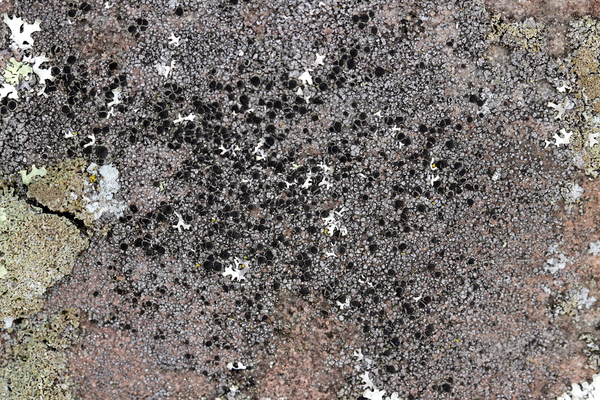Rinodina tephraspis (Tuck.) Herre
Proc. Wash. Acad. Sci., 12: 250, 1910. Basionym: Lecanora tephraspis Tuck. - Amer. J. Sci. Arts, ser. 2, 25: 425, 1858.
Synonyms: Rinodina arenaria (Hepp) Th. Fr.; Rinodina badiella (Nyl.) Th. Fr.; Rinodina glebulosa (Arnold) Arnold; Rinodina pannarioides Körb. ex Stein
Distribution: N - TAA (Arnold, Lich. exs. Nr. 494: UPS- L-168799), Lomb (Nascimbene & al. 2021).
Description: Thallus crustose, episubstratic, very variable, thin to thick, continuous to verrucose, subsquamulose or partly rimose-areolate, pale to dark grey or brown, often associated with cyanobacterial crusts in wet situations, sometimes delimited by a dark prothallus, the areoles sometimes sublobulate, rather loosely attached. Apothecia lecanorine, abundant, broadly attached to sessile, 0.5-1 mm across, with a a flat to convex, dark brown to black disc, and a thick, sometimes crenulate thalline margin; proper exciple distinct, persistent, visible from above as a parathecial ring. Thalline exciple 10-20 µm thick laterally, sometimes expanding in lower part to 20-30(-50) µm; proper exciple 10-25 µm wide laterally, expanding to 25-60 µm in upper part, often lightly pigmented; epithecium reddish brown, K-; hymenium colourless, 80-100 µm high; paraphyses 1.5-2.5 µm thick at mid-level, the apical cells 3-5.5 µm wide, with a brown cap; hypothecium colourless to lightly pigmented, (40-)60-110(-150) µm high. Asci 8-spored, clavate, the K/I+ blue tholus penetrated by a faintly amyloid apical cushion with parallel or diverging flanks, the wall K/I-, surrounded by a K/I+ blue outer layer, Lecanora-type. Ascospores 1-septate, brown, elongate-ellipsoid to broadly ellipsoid, 16-24 x 8-11(-14) µm, at first with Physcia-type loculi, finally grading into the Pachysporaria-type, with a well-developed torus and a faintly pitted wall, the ontogeny of type A (apical wall thickening after septum formation). Photobiont chlorococcoid. Spot tests: K-, C- or C+ pink, KC- or KC+ pink, P- (reactions best seen under the microscope on thick sections). Chemistry: with zeorin and variable, usually low amounts of 5-0-methylhiascic and lecanoric acids. Note: on siliceous rocks in upland areas, in moist and often shaded situations such as near waterfalls, rapids, gorges and shores of lakes, often associated with cyanobacteria (Stigonema).
Growth form: Crustose
Substrata: rocks
Photobiont: green algae other than Trentepohlia
Reproductive strategy: mainly sexual
Commonnes-rarity: (info)
Alpine belt: very rare
Subalpine belt: very rare
Oromediterranean belt: absent
Montane belt: extremely rare
Submediterranean belt: absent
Padanian area: absent
Humid submediterranean belt: absent
Humid mediterranean belt: absent
Dry mediterranean belt: absent

Predictive model
Growth form: Crustose
Substrata: rocks
Photobiont: green algae other than Trentepohlia
Reproductive strategy: mainly sexual
Commonnes-rarity: (info)
Alpine belt: very rare
Subalpine belt: very rare
Oromediterranean belt: absent
Montane belt: extremely rare
Submediterranean belt: absent
Padanian area: absent
Humid submediterranean belt: absent
Humid mediterranean belt: absent
Dry mediterranean belt: absent

Predictive model
 INDEX FUNGORUM
INDEX FUNGORUM
 GBIF
GBIF
 DOLICHENS
DOLICHENS


